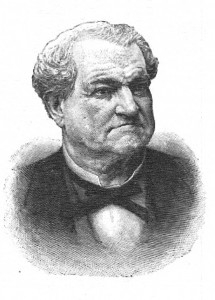Edmund Richardson facts for kids
Quick facts for kids
Edmund Richardson
|
|
|---|---|

Edmund Richardson, known as the "Cotton King"
|
|
| Born | June 28, 1818 |
| Died | January 11, 1886 (aged 67) |
Edmund Richardson (June 28, 1818 – January 11, 1886) was an American businessman who became very rich in the 1800s. He was famous for growing and selling cotton in states like Mississippi, Louisiana, and Arkansas. By the end of his life, he was known as the richest person in the South.
Contents
Early Life and Career
Edmund Richardson was born on June 28, 1818, in Caswell County, North Carolina. As a boy, he went to school for a few years. At age 14, he started working as a clerk in a store.
When he was 22, he received an inheritance from his father. This gave him the money he needed to start his own business. He moved to Jackson, Mississippi, and opened several stores in the area. In 1848, he married Margaret Elizabeth Patton, and they had seven children together.
Business During the Civil War
By the time the American Civil War started in 1861, Richardson was already a successful businessman. He owned five large cotton farms, called plantations, and several stores across Mississippi. He was also a partner in a company in New Orleans that specialized in the cotton trade.
The war created big problems for his business. The Union navy set up a blockade, which meant ships could not get to the port of New Orleans. This made it difficult to sell cotton, and Richardson's company went into debt.
Even with these challenges, Richardson was a smart businessman. After the war ended, he still had his farms and a large amount of cotton. He sold what he had, paid off all his debts, and his business was successful again within a year.
Becoming the "Cotton King"
Using Prison Labor
After the Civil War, life was very difficult in the South. Many people, including formerly enslaved African Americans, could not find jobs. As a result, prisons became very crowded.
In 1868, Richardson made an agreement with the government in Mississippi. He agreed to have state prisoners work on his large farms in the Mississippi Delta. In return, Richardson provided the prisoners with food, clothing, and guards. The state also paid him for their upkeep. This system was known as convict leasing.
The prisoners did hard work like building walls to prevent floods (levees), clearing land, and farming the fields. Using this labor allowed Richardson to grow enormous amounts of cotton very cheaply. This helped him build a massive fortune.
A Business Empire
By the 1880s, Richardson was incredibly wealthy. He owned beautiful mansions in New Orleans and Jackson. His business empire included:
- Dozens of cotton plantations in Mississippi, Louisiana, and Arkansas
- Country stores and banks
- Steamboats and railroads
- Mills for processing cotton seeds
- A controlling share in the Mississippi Mills, the largest textile factory in the South
His success earned him the nickname "The Cotton King." He was one of the biggest cotton growers in the world, with over 25,000 acres of land being farmed. He was also sometimes called "Colonel" Richardson, an honorary title given to important people.
In 1884, he helped lead a huge fair in New Orleans called the World's Industrial and Cotton Centennial Exposition. He even donated $25,000 of his own money to support it.
Death and Legacy
Edmund Richardson died suddenly on January 11, 1886, in Jackson, Mississippi. At the time, he was called "the richest man in the South and the largest cotton planter in the world." His fortune was estimated to be worth between 10 and 15 million dollars, which was an enormous amount of money back then.
He was buried in Greenwood Cemetery in Jackson. His monument is the tallest one in the cemetery and was specially carved by hand in Italy.


